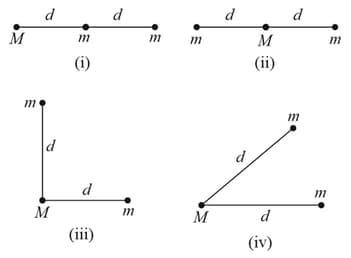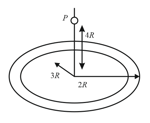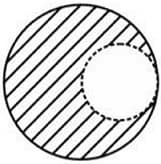Gravitational Field and Potential
Gravitational Field and Potential: Overview
This Topic covers sub-topics such as Gravitational Potential, Relation between Gravitational Field and Potential, Gravitational Field and Potential of Ring and, Gravitational Field and Potential of a Spherical Shell
Important Questions on Gravitational Field and Potential
The escape velocity for a planet is . A tunnel is dug along a diameter of the planet and a small body is dropped into it at the surface. When the body reaches the centre of the planet, its speed will be
Three particles, two with masses and one with mass, might be arranged in any of the four configurations shown below. Rank the configurations according to the magnitude of the gravitational force on least to greatest

A thin uniform angular disc (see figure) of mass has outer radius and inner radius . The work required to take a unit mass from the point on its axis to infinity is

Which of the following is true about the gravitational potential due to a point mass at a distance from the point mass?
The gravitational potential difference between a point on the surface of the planet and another point above is . Considering gravitational field to be uniform, how much work is done in moving a mass of from the surface to a point above the surface?
Two spheres each of mass and radius are separated by a distance of .If a line is joined in between the centres of the spheres, The gravitational potential at the midpoint of that line is
A small mass moved slowly from the surface of earth to a height of above the earth. Find the work done [in mega joule].(Radius of earth is )
Consider a planet moving in an elliptical orbit around the Sun. The work done on the planet by the gravitational force of the Sun:
Which of the following are correct?
A person brings a mass of from infinity to a point . Initially the mass was at rest but it moves with a speed of as it reaches . The work done by the person on the mass is . The potential at is:
If both the objects have the same curve as shown in the figure, then:
As Pluto moves from the perihelion to the aphelion, the work done by gravitational pull of Sun on Pluto is:
At perihelion, the gravitational potential energy of Pluto in its orbit has:
From a solid sphere of mass and radius , a spherical portion of radius is removed, as shown in the figure. Taking gravitational potential at the potential at the centre of the cavity thus formed is .

The gravitational field intensity at a point from the centre of the earth is . The gravitational potential at that point is,
A non - homogeneous sphere of radius has the following density variation:
Where is constant. The gravitational field at a distance from from the centre of the sphere is:
An asteroid of mass is approaching earth, initially at a distance with speed . It hits the earth with a speed ( and are radius and mass of earth), then
Six point masses each of mass are placed at the vertices of a regular hexagon of side .The force acting on any of the masses is
If is acceleration due to gravity on the earth's surface, then the gain in the potential energy of an object of mass raised from the surface of the earth to height equal to the radius of the earth is
From a solid sphere of mass M and radius R, a spherical portion of radius is removed, as shown in diagram. Taking gravitational potential at the potential at the centre of the cavity thus formed is: (G = Gravitational constant)

